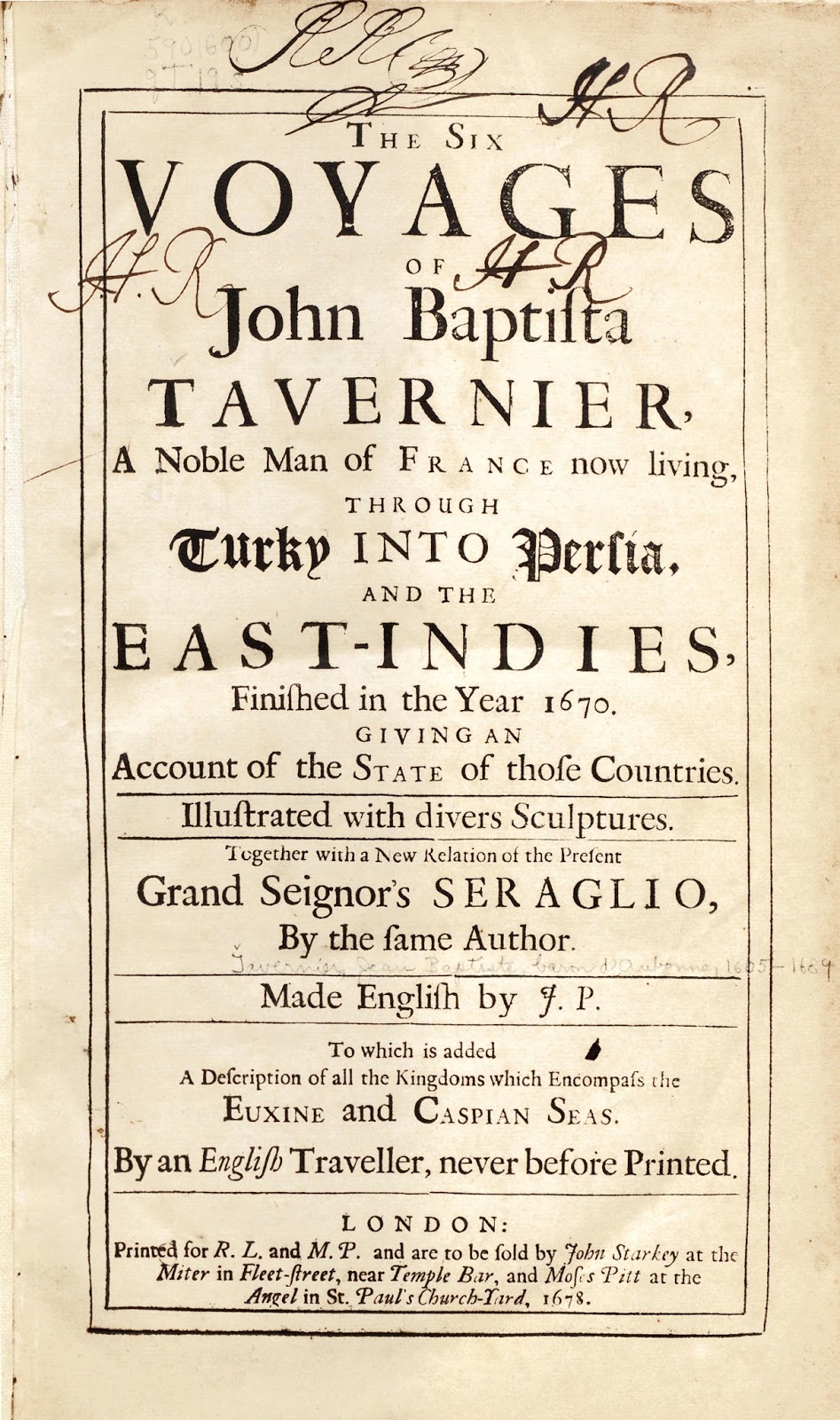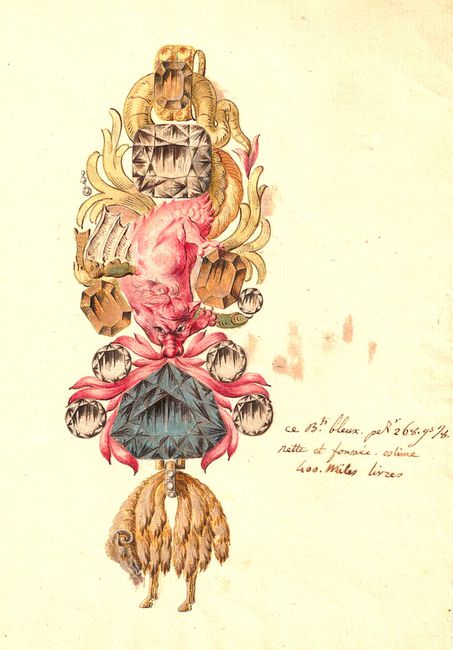From Jean-Baptiste Tavernier to the Smithsonian: Tracing the History of the Hope Diamond
 |
| The Hope Diamond. Photo by Chip Clark, courtesy of the Smithsonian Institution. Photo ID 97-35270. |
The Hope Diamond is one of the most famous gems in the world. It attracts millions of visitors to the National Museum of Natural History each year, making it one of the Smithsonian’s most popular objects.
But what is the history of this famous jewel? How did it come to be the Hope Diamond?
The known history of the stone begins with French gem merchant and traveler Jean-Baptiste Tavernier, whose travels through Asia in the 17th century are recorded in The Six Voyages of John Baptista Tavernier (1678), which has been digitized in BHL by the United States Geological Survey (USGS) Libraries Program.
 |
| Title Page. Tavernier, Jean-Baptiste. The six voyages of John Baptista Tavernier. 1678. Digitized by the United States Geological Survey Libraries Program. http://s.si.edu/2wq4rIQ. |
Born to a cartographer in 1605, Tavernier demonstrated a love for travel as early as his teens. Over the course of nearly forty years, Tavernier embarked on six major trips, or “voyages”, to Persia and India, covering by his account 180,000 miles. He became a successful jewel merchant and, according to the Smithsonian’s Mineral Sciences Department website, “the first European to describe the diamond mines in India.” He first published an account of his journeys in 1676 with Les Six Voyages de Jean-Baptiste Tavernier, with an English translation by John Phillips appearing two years later in 1678.
Most likely during his sixth and final voyage to India between 1664-1668, Tavernier obtained a remarkable blue diamond weighing approximately 115 modern metric carats. Dubbed the “Tavernier Blue,” the stone was certainly mined in India, but the specific mine is not known. Tavernier detailed this diamond in his Six Voyages.
 |
| Sketch of the “Tavernier Blue” (Upper Left, “A”). Tavernier, Jean-Baptiste. The six voyages of John Baptista Tavernier. 1678. Digitized by the United States Geological Survey Libraries Program. http://s.si.edu/2xkH0Vi. |
In 1668 or 1669 (sources vary), Tavernier sold the diamond to Louis XIV of France for 220,000 livres. According to François Farges, curator of minerals and gems at the Muséum national d’Histoire naturelle, the stone was likely worth twice that amount.
Why would Tavernier sell the gem so cheaply?
According to Richard W. Wise, author of The French Blue, Tavernier received a patent of nobility, likely as part of the deal, which at the time could be obtained for approximately 400,000-500,000 livres. Additionally, as Wise writes, selling the jewel to the King of France was good publicity for Tavernier. Furthermore, given the economic state of many other European royals at the time, Tavernier was unlikely to receive a better offer.
Louis XIV later ordered court jeweler Jean Pittan the Younger to recut the stone to reflect a more European style favoring symmetry and brilliance over size and weight. The resulting 69 carat heart-shaped diamond became commonly known as the “French Blue.” The diamond later became part of the Order of the Golden Fleece, a emblem of knighthood featuring many precious stones.
 |
| Color illustration of the Order of the Golden Fleece, containing the French Blue. Courtesy of the Smithsonian Institution. Creator: Pierre-André Jacqumin. https://mineralsciences.si.edu/_img/hope/GoldenFleece.jpg. |
Then, in 1789, France changed. The French Revolution ignited, and in 1791, the French Crown Jewels, including the Order of the Golden Fleece containing the French Blue, were turned over to the revolutionary government and moved to the royal storehouse, Garde-Meuble. The jewels were put on public display until 1792, when the French Blue, along with many other Crown Jewels, were stolen.
And here, the French Blue is lost.
Fast forward to London, 1812. A jeweler named John Francillon makes a note and sketches of a 45.5 carat blue diamond that he examined “by leave of” London diamond merchant Daniel Eliason. Known as the “Francillon Memo”, this is the first reference to the Hope Diamond as it is known today.
It was American gemologist and former “special agent” for the USGS, George Frederick Kunz, who unearthed this important piece of the Hope’s provenance when he discovered the “Francillon Memo” inside a copy of Pouget’s Traité des pierres précieuses et de la maniere de les employer en parure (1762) whilst browsing in London’s Quartich’s bookshop.
| The Francillon Memo inside a copy of Pouget’s Traité des pierres précieuses et de la maniere de les employer en parure (1762), from the USGS Libraries collection. Photo by: Kelly Haberstroh. |
Today, this memorandum, as well as the Pouget book it was discovered within, are part of the George F. Kunz Collection at the USGS Libraries Program. Containing many rare books on gemology, the folklore of gemstones through history, lapidary arts and archival gem trade records, the Library acquired this significant collection in 1933 after Kunz’s death. The copy of Tavernier’s Six Voyages within BHL is a part of the USGS Kunz Collection.
Interestingly, the “Francillon Memo” was dated September 19, 1812, just two days after the expiration of the statute of limitations for crimes committed during the French Revolution. In other words, France could no longer prosecute for reclamation of the diamond, should they happen to recognize the stone for what it truly was.
Whilst the connection between the French Blue and the Hope Diamond has long been suspected, in 2005 scientists at the Smithsonian announced that archival research and computer models had allowed them to conclude that the Hope was almost certainly cut from the French Blue.
The gem was most likely recut to hide its true identity. But who directed this to happen?
In 2009, Farges and his colleagues published research involving a lead model of the French Blue that suggests it may have been Henry Philip Hope, the diamond’s namesake, who privately acquired and directed the stone to be recut sometime between 1792-1812, after which it eventually ended up with Eliason, a client of Hope’s family firm. Hope would eventually officially acquire the diamond by 1839, after it was allegedly sold from George IV of England’s collection following his death in 1830 (George IV’s ownership of the Hope has never been officially confirmed).
In the early twentieth century, after Hope’s great-grandnephew, Lord Francis Hope (who inherited the Hope Diamond), sold the stone in the midst of financial difficulties resulting from his lavish lifestyle, the diamond passed through multiple owners before it was finally donated by jeweler Harry Winston to the Smithsonian in 1958.
 |
| Models of the Hope Diamond in its three known states: Tavernier Blue (top), French Blue (bottom left), and the Hope Diamond (bottom right). Courtesy of the Smithsonian Institution. Creator Stephen Attaway. https://mineralsciences.si.edu/_img/hope/HopeModels.jpg. |
Thus stands the history of the Hope Diamond, from its appearance in Tavernier’s Six Voyages to its exhibition at the Smithsonian. Thanks to the USGS Libraries Program, a record of the stone’s earliest known history is freely available to the world through the Biodiversity Heritage Library.
You can view all of the illustrations from Tavernier’s Six Voyages in the BHL Flickr.
About the USGS Libraries Program
The USGS Libraries Program, authorized by Congress in 1879, is the world’s largest earth and natural sciences library, providing services, collections, and expertise that are essential to the U.S. Geological Survey mission. The Libraries Program is made up of four branches that provide resources, collections, and services. The library collections include over 1,500,000 volumes, 2.500,000 maps, 30,000 field records, and 500,000 historical photos. Over thirty-six percent of the materials are unique to USGS, or available at ten or fewer libraries in the world. The rare collections can support research in biodiversity, specifically with literature from paleobotany and paleoclimatology as well as some surprising gems from early biological research both in the United States and across the world.
Sources
Buncombe, Andrew. 2005. “‘Cursed’ Hope Diamond Was Cut from French Stone, Test Shows.” The Independent, February 11. Accessed September 13, 2017. https://web.archive.org/web/20090331235958/http://www.independent.co.uk/news/world/americas/cursed-hope-diamond-was-cut-from-french-stone-tests-show-482819.html.
Farges, Francois, et al. 2009. “The French Blue and the Hope: New Data from the Discovery of a Historical Lead Cast.” Gems & Gemology 45, no. 1 (Spring): 4-19. Accessed September 13, 2017. https://www.gia.edu/doc/SP09.pdf.
The Public Domain Review. 2017. “The Six Voyages of John Baptista Tavernier.” Accessed September 13, 2017. http://publicdomainreview.org/collections/the-six-voyages-of-john-baptista-tavernier-1678/.
Smithsonian National Museum of Natural History. 2017. “Timeline.” Hope Diamond, April 19. Accessed September 13, 2017. https://mineralsciences.si.edu/collections/hope/timeline/1668.htm.
Wikipedia. 2017. “John Francillon.” September 1. Accessed September 13, 2017. https://en.wikipedia.org/wiki/John_Francillon.
Wise, Richard W. 2009. “From the Sun King to the Smithsonian The Epic Journey of the Hope Diamond.” The French Blue. Accessed September 13, 2017. http://thefrenchblue.com/article1.htm.





Leave a Comment